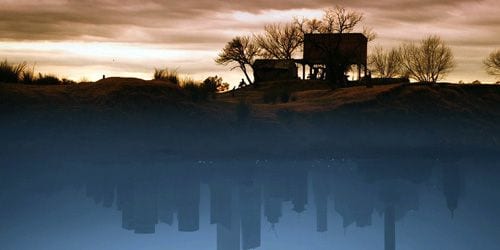
“How mysterious, there’s another world down there.”
Vivan Las Antipodas is more a dream than it is a film. Made up of shifting images and a smattering of languages, filmmaker Victor Kossakovsky’s documentary celebrates rich, human connections in worlds that are literally diametrically opposed. His hands-off approach to shooting the film allows the viewer to become immersed in a different world, sympathizing with the struggles and victories of others who are scattered across the globe. Whether in Shanghai, China or Entre Ríos, Argentina, Kossakovsky manages to capture the natural rhythm of the day, often setting it in brilliant counterpart against life on the other side of the globe.
The similarities and differences that color human life are at the heart of Kossakovsky’s documentary, which takes viewers on a tour of four sets of inhabited areas worldwide. These antipodes are exactly opposite one another on the globe so that if you passed a metal rod through the heart of one city, it would emerge in the heart of the other. Despite global overpopulation, antipodes that boast human inhabitants are relatively rare. The point of the film, though, is not to explain how these rarities came to be.
Rather, the locations in the film are articulated in the day-to-day activities of their inhabitants. Antipodes in Russia and Chile, Argentina and China, Botswana and Hawaii, Spain and New Zealand are put on display through a mix of intimate shots of people going about their daily lives and panoramic shots of the places they inhabit. It’s a hectic mix at times. The switch from a pair of men in the tiny village of Entre Ríos to a crush of motorcyclists trying to board a ferry in Shanghai is disorienting. “The world spins, but they’re always below us,” says one of the Argentinean men. It’s a sentiment visually echoed in the film.
As the viewer moves from one half of the antipodal pair to the other, there’s a real sense of rotation driven by heavily saturated landscapes and clever editing. It can be difficult to keep track of the different areas at times, especially as the film progresses. What seem like strikingly opposite places at first suddenly become more alike. The singular thing that makes them similar, of course, is the humans who live in these antipodal pairs. Though their lives are entirely different, the concerns and actions of individuals in different locations tend to be quite similar. It’s heartening, especially in a world where we tend to feel divided.
For all of the serious, humanist questions that it raises, Vivan Las Antipodas also offers up a great deal of pure visual delight. It’s touching to watch the two men in Entre Ríos maintain a bridge and collect a toll from the handful of cars that pass through every day. Kossakovsky prefers a wide shot for these scenes, capturing his subjects and tying them intimately to their places.
Sound is also used as an integral thread between the four antipodal pairs. The music introduced in each location is woven throughout, both to represent the essential character of the people in those places and to emphasize how people in very different situations can be alike. The locations are also given space to speak for themselves. Scenes from Hawaii, Spain and New Zealand in particular put focus on the sights and sounds of the natural environment.
Even in these astounding natural environments, we’re reminded of the ingenuity and essential quirkiness of people. One can’t help but smile as two teen girls in a small Russian village talk about reincarnation and fate. After the two men in Argentina give a puppy to a passerby, the older man calmly remarks, “That little dog will see more of the world than we ever did.” A sheep farmer in Patagonia, Chile names each of his sheep before they enter the pasture and is followed by a herd of cats. A mother in Botswana tells her toddler daughter not to be afraid of the elephants nearby. In the scope of the film, these moments are relatively small, but they matter the most.
Vivan Las Antipodas makes a persuasive argument for the materialist maxim that what people do determines to a large extent who they are. By focusing on what work and industry look like in each of his locations, Kossakovsky is able to illustrate how physical landscapes shape and nurture those who live in them.
The DVD release of the film doesn’t include any bonus features aside from the original theatrical trailer, but the disc doesn’t need them. There is a definite, dreamlike beauty in being able to construct an open narrative about our world based only on the images that we see and the snatches of conversation that we hear.

![Call for Papers: All Things Reconsidered [MUSIC] May-August 2024](https://www.popmatters.com/wp-content/uploads/2024/04/all-things-reconsidered-call-music-may-2024-720x380.jpg)



